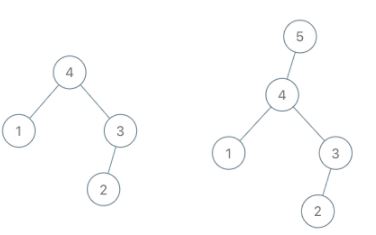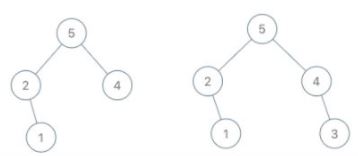- {x}
- Satisfiability of Equality Equations
- Broken Calculator
- Subarrays with K Different Integers
- Cousins in Binary Tree
- Rotting Oranges
- Minimum Number of K Consecutive Bit Flips
- Number of Squareful Arrays
- Find the Town Judge
- Maximum Binary Tree II
- Available Captures for Rook
- Minimum Cost to Merge Stones
- Grid Illumination
- Find Common Characters
- Check If Word Is Valid After Substitutions
- Max Consecutive Ones III
- Maximize Sum Of Array After K Negations
- Clumsy Factorial
- Read More...

Maximum Binary Tree II
A maximum tree is a tree where every node has a value greater than any other value in its subtree.
You are given the root of a maximum binary tree and an integer val.
Just as in the previous problem, the given tree was constructed from a list a (root = Construct(a)) recursively with the following Construct(a) routine:
- If
ais empty, returnnull. - Otherwise, let
a[i]be the largest element ofa. Create arootnode with the valuea[i]. - The left child of
rootwill beConstruct([a[0], a[1], ..., a[i - 1]]). - The right child of
rootwill beConstruct([a[i + 1], a[i + 2], ..., a[a.length - 1]]). - Return
root.
Note that we were not given a directly, only a root node root = Construct(a).
Suppose b is a copy of a with the value val appended to it. It is guaranteed that b has unique values.
Return Construct(b).
Example 1:

Input: root = [4,1,3,null,null,2], val = 5 Output: [5,4,null,1,3,null,null,2] Explanation: a = [1,4,2,3], b = [1,4,2,3,5]
Example 2:

Input: root = [5,2,4,null,1], val = 3 Output: [5,2,4,null,1,null,3] Explanation: a = [2,1,5,4], b = [2,1,5,4,3]
Example 3:

Input: root = [5,2,3,null,1], val = 4 Output: [5,2,4,null,1,3] Explanation: a = [2,1,5,3], b = [2,1,5,3,4]
Constraints:
- The number of nodes in the tree is in the range
[1, 100]. 1 <= Node.val <= 100- All the values of the tree are unique.
1 <= val <= 100
Solution Explanation for LeetCode 998: Maximum Binary Tree II
This problem asks to insert a new node with value val into a maximum binary tree. A maximum binary tree is a tree where every node's value is greater than any node in its subtree. The insertion should maintain this maximum tree property.
Approach 1: Recursive Solution
This approach leverages the recursive nature of constructing a maximum binary tree. We recursively traverse the tree, looking for the appropriate place to insert the new node.
Algorithm:
- Base Case: If the current node is
nullor its value is less thanval, create a new node withvaland make the current node its left child. This new node becomes the new root of the subtree. - Recursive Step: Otherwise, recursively call the function on the right subtree with
val. This ensures thatvalis inserted into the correct position within the right subtree, maintaining the maximum tree property.
Time Complexity: O(N), where N is the number of nodes in the tree. This is because in the worst case we traverse the entire tree. Space Complexity: O(N) in the worst case due to the recursive call stack. The recursion depth can be at most N if the tree is skewed.
Approach 2: Iterative Solution
This approach avoids recursion by iteratively traversing the tree to find the correct insertion point.
Algorithm:
- Base Case: If the root's value is less than
val, create a new node withvaland make the root its left child. This is the new root. - Iteration: Otherwise, start at the root and traverse the right subtree. As long as we encounter nodes with values greater than
val, continue traversing to the right. - Insertion: When we find a node whose right child's value is less than or equal to
val, create a new node withval, make the current node's right child the left child of the new node, and then set the new node as the current node's right child.
Time Complexity: O(N), where N is the number of nodes in the tree. In the worst case, we might traverse the entire right branch. Space Complexity: O(1). We are using only a constant number of extra variables.
Code Examples (Python)
Approach 1 (Recursive):
class TreeNode:
def __init__(self, val=0, left=None, right=None):
self.val = val
self.left = left
self.right = right
class Solution:
def insertIntoMaxTree(self, root: TreeNode, val: int) -> TreeNode:
if not root or root.val < val:
return TreeNode(val, root)
root.right = self.insertIntoMaxTree(root.right, val)
return root
Approach 2 (Iterative):
class Solution:
def insertIntoMaxTree(self, root: TreeNode, val: int) -> TreeNode:
if not root or root.val < val:
return TreeNode(val, root)
curr = root
node = TreeNode(val)
while curr.right and curr.right.val > val:
curr = curr.right
node.left = curr.right
curr.right = node
return rootThe code examples in other languages (Java, C++, Go, TypeScript, Rust, C) follow similar logic, reflecting the algorithms described above. The choice between the recursive and iterative approach is often a matter of preference and potential considerations about stack overflow in very deep trees (favoring iterative in those scenarios). Both have the same asymptotic time complexity.